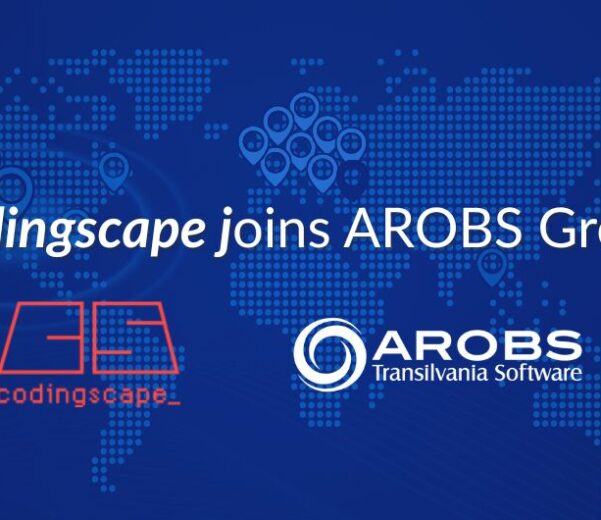AROBS Transilvania – custom software development company
Serious Games for Professionals
There is more to games than just the entertainment side. Skeptic on this statement? Well, our colleague Ana is here to change your mind with valid arguments. You can bring mind-training games into the software development teams!
Ana-Iulia E., Java Developer in the AROBS Enterprise Solutions business line, highlights that one can use serious games in various custom enterprise software development areas. From learning programming fundamentals to carrying out code reviews and understanding Agile Methodologies, games help facilitate professional processes in a fun manner.
Read our colleague’s article until the end to learn how to apply the four stages of the Activity Theory Based Model for Serious Games in the professional environment.
Games have always been around us. We grew up with them, and many times, without realizing it, they helped us develop different skills over time. But are games only for children? Once you become an adult, do you still need them or have time to play? Well, whether it’s soft skills or knowledge in specific fields, the game is the least stressful and fastest way to learn and overcome your limits without fear of making mistakes.
Well, this is not about any type of game; it’s about serious games. These are called “serious” because they combine learning objectives with business goals.
1. The emergence of the Serious Games concept
At first glance, the notion of serious games is an oxymoron. The two terms have been put together since the Renaissance novels, but the real meaning, which is still used today, was given by the researcher Clark Abt during the Cold War. He presented serious games used in various fields such as education, social sciences, and, above all, for the training of military officers. Initially, most of the first programs created for computers were intended for military purposes, from ballistic calculations to computer simulations.
If we refer to the current definitions, any digital game whose objective exceeds the simple purpose of entertainment can be considered a serious game. Nowadays, a serious game is analyzed from a rational, analytical, and emotional point of view because these components can be found in different aspects of life, which, introduced in games, train motivation, curiosity, and teamwork.
2. Serious Games in the training of professionals
Nowadays, there is an extensive range of applications for serious games. From the games that help introduce the fundamentals of various programming languages, and train logic, to the best practices in carrying out code reviews, to the development of agile work teams, and above all, they are used by companies in employee training.
In corporate training, serious games have gained popularity in the recruitment process and onboarding, as well as in employees’ personal and professional development.
Lately, the concept of “Agile Methodologies” has developed a lot. It aims to deliver faster high-quality products that satisfy the customer’s needs, applying lean production principles to software development. A fundamental concept in this process is the interaction between people and collaboration with the client. Thus, serious games for teams have been developed to facilitate the understanding of the Agile Manifesto and the application of the principles it is based on.
3. Hands-on Serious Games development
Serious games aim to challenge the players to put themselves in various situations, apply their knowledge, and even analyze the actions of other players. To do this, it is vital to use a framework based on three activities: playing, learning, and training. Therefore, the Activity Theory Based Model for Serious Games (ATMSG) involves four stages of analysis that contribute to the implementation of activities.
- The first step: description of the main activities and identification of subjects, which helps to observe the game from different complementary angles;
- The second step: creating the game in the form of a UML diagram to identify the main elements and how they are interconnected;
- The third step: elements are identified within the nodes of the completed game sequence, created at the previous step, and are divided into the following categories: actions, tools, and objectives;
- The fourth step: each set of actions, tools, or objectives is grouped according to the type of activity and according to each node in the game sequence. For each grouping, the implementation is detailed, explaining what action is carried out, by what tools, with what purpose, and how it contributes to the pedagogical approach of the game.
4. Conclusion
By reflecting on how serious games appeared, their purpose in the past, and their role today, this article wants to spark curiosity about the proposed subject.
How would you develop your own serious game?
Bibliography
- Djaouti Damien, Alvarez Julian, Jessel Jean-Pierre, Rampnoux Olivier, Origins of Serious Games, 2011, Serious Games and Edutainment Applications (pp.25-43), Edition: 1, Chapter: Origins of Serious Games, Springer London
- Callaghan, M., McShane, N., Eguíluz, A. G., & Savin-Baden, M. (2018). Extending the Activity Theory-Based Model for Serious Games Design in Engineering to Integrate Analytics. International Journal of Engineering Pedagogy (iJEP), 8(1), pp. 109–126
// If you’re looking for a software services partner to help your business adapt to change, leave us a message
Looking for a digital upgrade?
// our recent news




